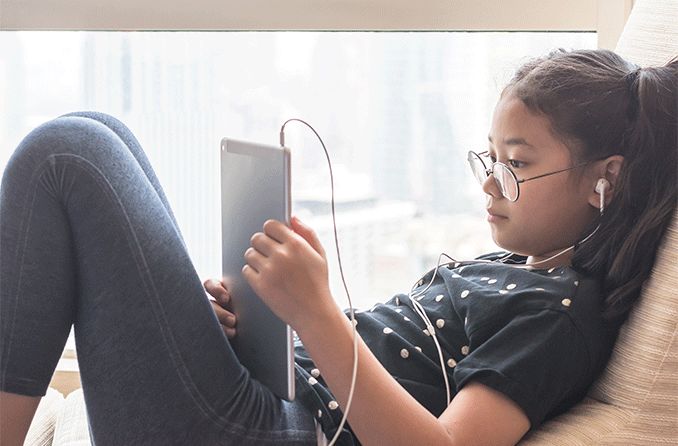How to care for children’s vision during the coronavirus pandemic

Due to the COVID-19 pandemic, many schools have had to transition to virtual learning. While this change has now settled into a new normal, students still face some limitations in both learning and former at-school health services, including vision screenings.
Vision screenings are scheduled and performed during the school year to ensure children aren’t having trouble seeing as they learn. While these screenings do not provide a comprehensive look into eye health, they do help identify basic vision concerns and encourage parents to schedule professional eye exams when necessary for their children.
At-school vision screenings may be limited, but there are some things parents can do to promote healthy vision at home during these somewhat unusual times — from using downloadable vision charts, to encouraging children to step away from digital screens whenever possible.
Why vision screenings are important for children
Vision screenings given at school provide basic information about how well children are able to see from short and long distances (visual acuity). Visual acuity can change from year to year, especially throughout childhood.
Whether or not your child is vocal about vision changes — or whether or not he or she has noticed any — these at-school vision screenings are the first step in making sure they are acknowledged and corrected by an eye doctor.
With this being said, proper care for vision is crucial during developmental years. Regular eye exams help care for vision beyond school screenings, as they provide insight into all vision concerns, from refractive errors to eye diseases.
Can eye exams be given at home?
Though vision screenings provide a baseline of information about your child’s vision, they are still somewhat involved and cannot replace an exam by a licensed eye care professional.
School nurses are specially trained to perform vision screenings for students. During the exam, a school nurse looks for any indicators that a child is having difficulty reading an eye chart, and can professionally draw conclusions about whether or not they may need glasses.
School nurses then report this information to the parent, and it is up to the parent to schedule an eye exam with an eye doctor.
Can this process be done at home by the parent? Technically, yes. Some digital applications can be downloaded to test your child’s vision on a basic, unofficial level at home. Certain eye charts are also downloadable online.
It is important to note that these basic tests do not replace comprehensive eye exams. If your child has difficulty reading any chart, it is likely time to schedule an appointment with an eye doctor to have their vision fully evaluated.
Do not hesitate to confirm special COVID-19 safety protocols with your doctor’s office before scheduling and/or arriving for an appointment.
READ MORE: Eye doctors add safety measures to cut COVID-19 risk
Too much screen time affects vision
Virtual learning requires children to view digital screens for several hours every day. While this is a necessity for the school day, prolonged viewing of electronic screens can have negative effects on your child’s vision.
Too much screen time can cause digital eye strain, blurry vision and dry eyes, among other discomforts. Focusing at near for long periods can be tiring. The eyes can begin to burn and feel dry because the blink frequency slows down when someone looks at a screen for an extended period. Blue light emitted from digital screens can cause glare.
Many digital devices include a “night mode” setting, and some applications can help tone down blue light as your child uses a computer or tablet for school. Computer glasses with an intermediate prescription, anti-reflective coating and blue light filtering lenses may be a good option to keep your child comfortable.
SEE RELATED: Children and technology: Protecting your child's eyes
Spending time outdoors is beneficial to both the body and the eyes
While digital screens give off harmful blue light, natural outdoor lighting includes blue light that is actually beneficial for vision health.
For children specifically, daylight plays an important role in promoting healthy eye development. A study published by the American Academy of Ophthalmology found that sunlight exposure can even help lower the risk of nearsightedness in children.
Before the pandemic began, children were given scheduled opportunities to play outdoors during the school day during activities such as recess. And while recess and other outdoor learning may not be on the class schedule for virtual learning, it doesn’t make it any less important in a homeschooling environment.
Whether or not outdoor play is available for your child during the school day, it is critical to make sure their indoor learning environment is brightly lit, as poor indoor lighting can cause eye strain and potentially disrupt learning.
SEE RELATED: Is the COVID-19 lockdown affecting children’s vision?
Keep vision healthy during the COVID-19 pandemic
Vision is one of the many components of health that the pandemic has taken a toll on, for both adults and children. Fortunately, there are a variety of ways to keep your and your children’s vision healthy and happy while you are at least somewhat confined to your home, including:
Limit screen time when possible.
Make time for outdoor play and exercise.
Encourage your child to participate in activities that don’t require a screen, such as reading books or playing board games.
Practice proper hygiene.
Pandemic or not, routine eye exams are also important in keeping vision healthy and clear. Consult an eye doctor if it’s been a while since your child’s last exam or if your child’s vision has changed, and confirm office safety protocols with staff before your appointment.
READ NEXT: Patients returning to eye doctors during COVID-19 pandemic
Page published on Tuesday, February 16, 2021






